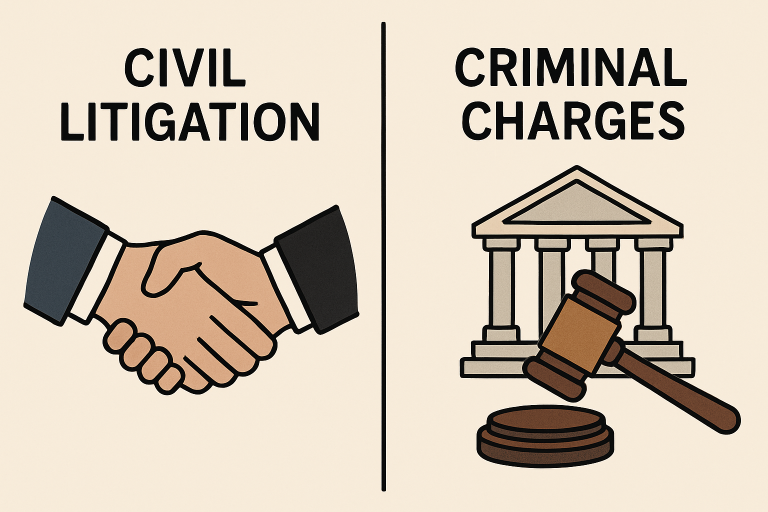
Key Takeaways
- Different purposes: Civil litigation resolves private disputes, focusing on compensation or enforcing rights, while criminal law addresses offenses against society, emphasizing punishment and public safety.
- Who brings the case: Civil cases are filed by private individuals or businesses; the government brings criminal cases.
- Standard of proof: Civil cases require a lower standard (“preponderance of the evidence”), while criminal cases require proof “beyond a reasonable doubt.”
- Legal protections: Criminal defendants have stronger constitutional protections, including the right to remain silent and the right to a court-appointed attorney; civil defendants generally do not.
- Outcomes and penalties: Civil cases typically result in monetary damages or court orders, while criminal cases can lead to fines, probation, or imprisonment.
- Overlap is possible: A single incident can lead to both a criminal case and a separate civil lawsuit.
- Why it matters: Understanding these differences helps you know what to expect, protect your rights, and make informed legal decisions.
When navigating the complex world of the legal system, understanding the distinction between civil litigation and criminal charges is crucial. These two areas of law serve distinct purposes and can have a profound impact on individuals, families, and communities. Civil litigation typically resolves private disputes and seeks to compensate those who have been harmed, while criminal law is concerned with offenses against society as a whole. If you are facing any legal challenge, understanding the basics can help you make informed decisions and protect your rights. For more details on legal representation in both civil and criminal matters, visit Martinlawfirmpc.com.
Legal actions are stressful and confusing, especially when the stakes are high. Whether you have suffered harm due to someone else’s actions or are accused of wrongdoing, being able to distinguish between civil and criminal matters will help you understand what to expect from the process, your legal rights, and what the outcome may mean for your future.
Purpose and Objectives
Civil Litigation: The primary purpose of civil litigation is to resolve conflicts between private parties, be they individuals, businesses, or organizations. It is not about punishment, but rather about securing compensation or enforcing rights. Typical civil cases include disputes over contracts, business disagreements, property boundaries, personal injury, and family law matters such as divorce or custody issues.
Criminal Charges: In contrast, criminal law centers on offenses perceived as attacks against the entire society. The government files charges, prosecutes the case in court, and seeks a penalty—ranging from a fine to years of incarceration, depending on the severity of the crime. The goal is not to compensate victims, but rather to uphold public order, deter crime, and rehabilitate offenders. Crimes such as theft, assault, fraud, or homicide fall into this realm.
For further reading on the interaction and differences between criminal and civil law, see this overview of criminal law provided by Britannica.

Initiation of Cases
Civil Cases
Civil cases are initiated by a private individual, business, or organization known as the plaintiff. The plaintiff files a lawsuit against another party, known as the defendant, typically seeking monetary damages or legal remedies, such as an injunction (an order to do or refrain from doing something). The process begins with a complaint filed in civil court, which outlines the basis of the dispute, the harm suffered, and the relief sought.
Criminal Cases
Criminal cases are brought forward by the government, which is represented by a prosecutor or district attorney. Here, the state acts as the plaintiff and charges an individual or an organization with violating the law. The case typically begins with a police investigation, followed by an arrest and the filing of formal charges. The victim’s primary role is to serve as a witness, not as a party to the suit.
Burden of Proof
Civil Cases
In civil litigation, the burden of proof falls on the plaintiff, who must show their case by a “preponderance of the evidence.” This means the proof must tip the scale slightly in favor of one side—if it is more likely than not that the defendant is responsible, the plaintiff prevails.
Criminal Cases
Criminal cases require a much higher standard of proof: “beyond a reasonable doubt.” The government has to convince the judge or jury that there is no reasonable doubt about the defendant’s guilt, as the consequences—potential loss of liberty or even life—are severe. This high bar is essential to protect innocent people from wrongful convictions. For a deep dive into the concept of burden of proof, see this explanation provided by the Legal Information Institute.
Legal Rights and Protections
Civil Defendants
Those sued in civil court have fewer constitutional protections than those in criminal cases. For example, the right to a court-appointed attorney does not exist in most civil cases; defendants must either hire their own lawyer or represent themselves. Additionally, civil defendants can typically be compelled to testify, which means they have no protection against self-incrimination.
Criminal Defendants
Defendants facing criminal prosecution are entitled to additional safeguards under the law. These include the right to remain silent, the right to avoid double jeopardy (being tried twice for the same offense), and the right to a government-provided attorney if they cannot afford one. These procedures are designed to help prevent the severe consequences of a wrongful conviction.
Penalties and Consequences
Civil Cases
Penalties in civil cases typically involve monetary payments or other court orders directing the defendant to perform or cease specific actions. For example, a court may order a business to fulfill the terms of a contract or a landlord to compensate a tenant for damages to their property.
Criminal Cases
The penalties stemming from criminal convictions are significantly more severe and may include jail or prison sentences, probation, community service, or substantial fines. The goal here is both punishment and deterrence, aiming to protect the public from further harm by the offender.
Examples of Overlapping Cases
Sometimes, a single event can give rise to both a criminal and a civil case. For instance, if someone commits assault, the government may prosecute the offender for breaking the law. At the same time, the victim may sue separately for damages, such as medical bills and pain and suffering.
Conclusion
Understanding the differences between civil litigation and criminal charges is vital for protecting one’s rights and navigating the legal system efficiently. Each follows distinct procedures and leads to different outcomes. If you are facing or considering either type of case, seeking professional legal guidance ensures your interests are fully addressed during what can be a complex and intimidating process.


